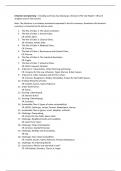Summary
Urbanism & Planning: Including lecture notes, summary of the City Reader, key takeaways and graphs!
- Course
- Institution
- Book
This PDF includes: - Lecture notes (both midterm and final exam). My notes are not just powerpoint notes, but instead full lecture notes including extra information. - Additional information and graphs used during the lecture. -Summary of the literature: City Reader. -In some cases a Dutch t...
[Show more]




